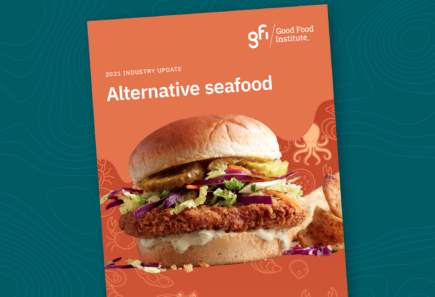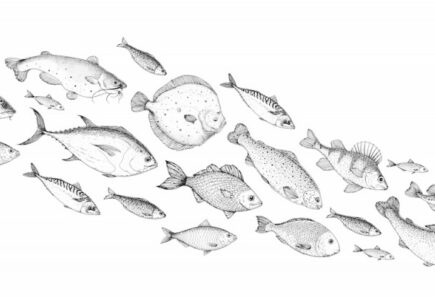Cultivated, fermentation-derived, or hybrid surimi
There has been little publicly announced R&D and commercial effort to develop cultivated, fermentation-derived, or hybrid surimi. Compared to other meat products, surimi is likely to be by far one of the easiest to replicate well.
-
Cultivated
-
Fermentation
- Research
- Commercial
- End Products
- End product formulation & manufacturing
- Target molecule selection
- Industry
- Investors
- Startups
Current challenge
There has been little publicly announced R&D and commercial effort to develop cultivated, fermentation-derived, or hybrid (non-animal meat and plant-based in combination) surimi. Surimi is a food product composed largely of muscle proteins, as opposed to whole animal cells. Compared to other cultivated meat (CM) products, surimi is likely to be easier to replicate well because of this low structural complexity.
Conventional production faces issues of waste and variability
Conventional surimi production creates problematically high production wastes (an active investment area for companies and researchers). The non-filet portion of the whole fish (60 – 70% (Jaziri et al. 2021) ) is discarded upfront, typical of many fish products. The fish filet is further processed to generate the myofibrillar protein concentrate that makes up surimi. An additional 10 – 45% of the protein is lost in this processing (Xiong 2018). Reports on surimi wastewater indicate they may contain up to 0.5 – 2.3% protein (Stine et al. 2012).
Product variability also challenges conventional surimi. Surimi is typically produced from lower commercial-value fish species like Alaska pollock and Pacific whiting. The variation in fish species used to produce surimi has been found to lead to variation in surimi product characteristics (Fahrizal et al. 2018). A challenge that is fairly unique to surimi as a highly-processed and gelled protein concentrate is the impact of seasonal variability of the fish harvest on protein thermal stability (He et al. 2019), which impacts protein unfolding during chopping and gelling.
Unstructured aquatic CM is a relatively unexplored area
The focus of current aquatic CM is high price point and luxury meat products (e.g., BlueNalu’s bluefin tuna toro). There are fewer companies working towards addressing low structural complexity and low price point end products (such as surimi). Fisheroo’s surimi and Bluu Seafood’s fish balls are two products under development that may fall into this classification.
There are advantages in pursuing low structural complexity and low price point aquatic CM. This would allow more consumers to have access to aquatic CM products. Simpler products might be more amenable to early commercialization, scale-up, and cost reduction efforts even as companies and researchers work to tackle the challenges associated with structured products. Another advantage is to align with terrestrial CM, which has already made commercial in-roads in this domain (e.g., Ivy Farm’s cultured sausage). This could encourage investments and technological advances in terrestrial CM to consider unique aquatic CM characteristics, making sure terrestrial CM advancements are as translatable into aquatic CM as possible.
Proposed solution
Cultivated, fermentation-derived, and hybrid surimi offer unrealized value to the surimi marketplace and cultivated meat industry.

Cultivated surimi
The process flow of cultivated surimi could look very similar to the general science of cultivated meat, with a few noticeable (and potentially advantageous) differences:
- The low fat content of surimi of less than 1% dry weight (Moosavi-Nasab et al. 2019) may simplify the cell proliferation, differentiation, and formulation steps.
- The low structural complexity of surimi eliminates scaffolding, further simplifying differentiation and lowering costs.
- Surimi, as a myofibrillar protein concentrate, may not need all of the valuable cellular components (e.g., lipids) produced during the cell proliferation phase, forming a potentially useful sidestream to harness.
Fermentation-derived surimi
Producing surimi myofibrillar proteins using precision fermentation would bypass the need to cultivate lesser-investigated fish cells in favor of simple and well-understood microbial cells. Precision fermentation can be used to maximize production of the surimi proteins while minimizing production of the side-streams that cultivating fish cells generates. The protein-based surimi is a particularly compelling candidate for this approach. There may be opportunities to investigate lowering processing post-fermentation (e.g., via extracellular localization of the protein product) as compared to the post-fish cell cultivation processing requirements for cultivated surimi products.
Hybrid surimi
Combining cultivated meat (or fermentation-derived proteins) with plant-based meat, defined as a hybrid product, is another viable solution for surimi products with improved taste, cost, and sustainability. Initial progress has already been made to produce surimi containing a blend of pea protein (up to 10%) (Borderías et al. 2020). Further research is broadly needed to develop hybrid surimi products and bring them to market.
Surimi to support a circular bioeconomy
Conventional surimi is produced from a variety of animals including tropical fish (Jaziri et al. 2021), freshwater fish (Yingchutrakul et al. 2022), and even terrestrial organisms (Cortez-Vega et al. 2015). The flexibility of raw material inputs for surimi production creates an opportunity to utilize the side- and waste-streams of other alternative protein production systems as inputs for surimi production. Existing conventional surimi literature supports this concept. For example, surimi-like gel has been produced using catfish byproducts (Zhang et al. 2022).
Alternative protein solutions for luxury surimi
There are pathways for a luxury, or enhanced, surimi product. For example, cultivating crustacean cells in lieu of white fish, either as substitute or supplement, could impart superior flavor and textural profiles to conventional surimi. In a way, this could also be regarded as a “more authentic” imitation crab product. Similarly, exceptional flexibility and diversity of the precision fermentation platform also lends itself to luxury surimi opportunities. Recent movements in the market (e.g., “crab tsumami” surimi from Maruha Nichiro) suggests that there may already be interest in luxury surimi.
Anticipated impact
Alternative protein solutions to surimi products can solve current and upcoming production blockers such as input variability and high waste production. They offer accessible pathways into commercialization of alternative protein seafood products because of their minimal structural complexity and large market – surimi products represent 2-3% of global seafood production, Furthermore, the low fat content of surimi products further simplifies the production process and means surimi is less sensitive to bottlenecks related to animal-free omega-3 fatty acid supply compared to products like salmon and shrimp. Replacing surimi with cultivated, fermentation-derived, or hybrid surimi creates a more efficient production system by reducing waste, promoting a circular bioeconomy, reducing consumer exposures to environmental pollutants (Li et al. 2022), and providing another protein-rich, affordable food option for consumers.
The low price point of surimi (cited around $3/kg to $6/kg) and growing fishery capacity for fish like Alaska pollock are perhaps the largest barriers to adoption. Technology advances in cultivated meat must be made to lower costs to competitive levels from where current analysis pinpoints production costs (best case $6.43/kg). Developing hybrid surimi is one approach to reduce product costs in the near term horizon. The growing pains of production scale-up for any given process are difficult to project. This in turn means that it is also hard to predict whether simple, low-cost products or complex, high-cost products are going to have an easier time achieving price parity. Investigating both product approaches mitigates risk.
Cultivated, fermentation-derived, and hybrid surimi products could be a strategy to introduce low-cost goods into the array of commercial-potential alternative protein seafood products. A balanced portfolio of alternative protein seafood products coming to market provides an opportunity for a more flexible and representative showcasing of consumer perception. Similarly, within the alternative protein solutions to surimi themselves, a parallel approach of a low-cost and luxury product could yield similar effect.
Related efforts
Opportunities/resources/projects
- USDA-funded research project “Capacity building in plant-based seafood at NC A&T State University by development of a research program in fish-less imitation crab meat (surimi)”. Accession No: 1030236
- A review of plant-based seafood analogs that includes plant-based surimi. Kazir et al. 2021.
Companies
GFI resources

State of the Industry Report: Alternative seafood
Our report explored the global alternative seafood industry’s commercial landscape and shared the latest on investment, sales data, and consumer insights in 2021.

Introducing PISCES, a new data navigation tool to inform alternative seafood development
There’s a lot of research on the cellular and molecular components needed to match conventional seafood’s taste, texture, and aroma. We’ve put together a resource to help alternative seafood researchers…
Meet the author

Matt McNulty
GFI RESEARCH FELLOW
University of California, Davis

Find collaborators
Join the GFIdeas global community of 2,000+ entrepreneurs, scientists, investors, and subject matter experts. Discuss projects on the members-only Slack community, attend monthly seminars, and use the community directory to help you find collaborators working on similar Solutions!
Related solutions
-
Cultivated
Promoting stemness and proliferation in fish cell cultures
Efficient and cost-effective cultivated fish production will require precise optimization to encourage fast proliferation and highly efficient use of inputs while preventing premature differentiation. A variety of strategies can be…
-
Cultivated
-
Fermentation
-
Plant-Based
Hybrid products to optimize nutrition, taste, cost, and sustainability
Hybrid products are a promising means to introduce cost-competitive versions of cultivated meat to the market while improving the taste of plant proteins. Promoting the health benefits of hybrids may…

Explore the full solutions database
Browse 100+ startup ideas, commercial opportunities, research projects, and investment priorities throughout the alternative protein supply chain.
Get involved
If you’d like to fund a research project, work on any of these solutions, share information about related efforts that are already underway, or elevate new ideas for advancing the alternative protein industry, we’d love to hear from you!
